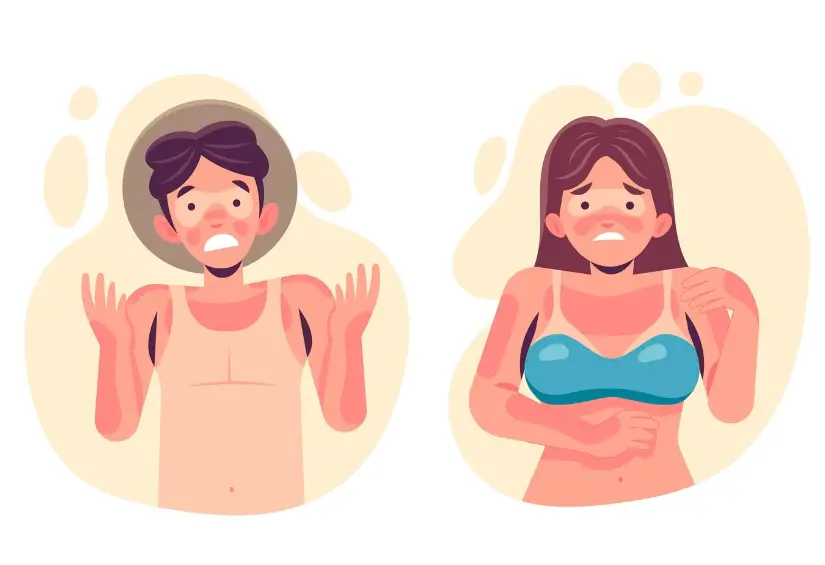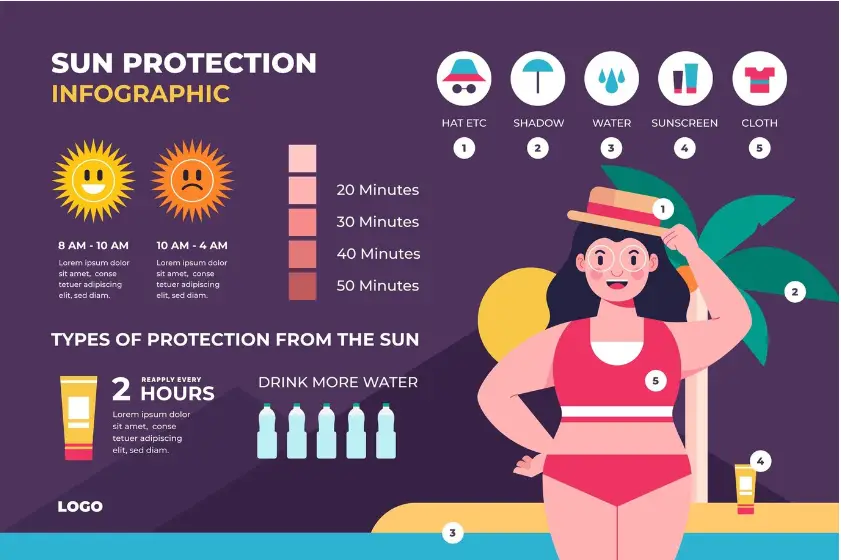Understanding Sun Tan: 7 Myths, Facts, and Tips for a Healthy Glow
Table of Contents
Don’t let sun tan ruin your fun! Learn the truth about sunscreen myths and how to keep your skin healthy in the sun.
What is Sun Tan?
Definition of sun tan :

Ever notice how your arms and legs get darker after a day at the beach? That’s a sun tan! It’s like your skin is putting on a shield to protect itself from the sun’s rays. Here’s the lowdown:
- Sunshine has sneaky rays called ultraviolet (UV) rays that we can’t see.
- These UV rays can be a bit rough on your skin.
- To fight back, your body sends out tiny factories called melanocytes.
- These factories make a special superhero shield called melanin.
- Melanin absorbs those UV rays, stopping them from hurting your skin cells. The more melanin you have, the tanner you look!
- That’s why your exposed areas like arms, legs, face, and neck get tanner – they’re the ones getting hit by the most sunshine!
Think of a suntan as your body’s built-in sunscreen. Pretty cool, huh? But remember, even with a sun tan, it’s still important to be sun smart! Sunscreen, hats, and sunglasses are your best friends when playing outside.
Causes of sun tan :
here’s a breakdown of what causes a suntan in super simple terms:
Sun + Skin = Tan!
That’s the short story, but here’s the science-y reason behind it:
- Sunshine has sneaky rays called ultraviolet (UV) rays that we can’t see.
- When these UV rays hit your skin, your body is like, “Woah, gotta protect myself!”
- It then sends out special cells called melanocytes that make a kind of superhero shield called melanin.
- Melanin is like tiny sunglasses for your skin cells, soaking up those UV rays.
- The more melanin you have, the more protection you get, and the tanner you look!
So, a sun tan is your body’s natural way of putting on sunscreen from the inside out. Pretty cool, right?
Skin Types and how they react to the sun:

Everyone’s skin reacts a little differently to the sun. Here’s a quick guide to see how yours might behave:
- Fair Skin (Pale White or Light Beige): This skin is super sensitive to the sun and burns easily. It won’t really tan much, so be sure to shade up and wear sunscreen!
- Light Skin (Beige): This skin type can still burn easily, but it might develop a light brown tan after some sun exposure. Play it safe and use sunscreen!
- Light Brown Skin: This skin tone is less likely to burn and can tan to a nice moderate brown colour. Sunscreen is still a must to protect your skin!
- Olive Skin (Moderate Brown): Lucky you! This skin type rarely burns and tans beautifully to a deep brown. But don’t be fooled – sunscreen is important for everyone, even darker skin tones.
- Dark Skin (Dark Brown or Black): This skin has the most natural sun protection thanks to melanin. It rarely burns and tans very easily. Sunscreen is still a good idea to prevent sun damage, even for darker skin tones.
Remember: No matter your skin colour, sun protection is key! Sunscreen, hats, and sunglasses are your best friends for safe fun in the sun.
Myths about Sun Tan

Sunscreen is super important for taking care of your skin, but there’s a lot of wrong info out there about how to use it. This can make it tough to know how to really shield yourself from the sun’s rays. At Academic Alliance in Dermatology, we want to give you the straight facts so you can make the best choices for your skin’s health. We’re going to bust some common myths about sunscreen and tell you the truth to keep your skin glowing and healthy.
Myth 1: Sunscreen lasts all day
Sunscreen wears off after a while, especially if you’re sweating, swimming, or toweling off. Experts say to put it on every two hours, and even more often if you’re getting wet or working up a sweat.
Myth 2: Darker skin doesn’t need sunscreen
Everyone needs sunscreen, no matter your skin color. While darker skin has some natural protection, it can still get hurt by the sun. Sun can cause wrinkles, dark spots, and even skin cancer. Sunscreen helps prevent all that!
Myth 3: Makeup with SPF is enough
Makeup with SPF is a good start, but it usually doesn’t put on enough protection. We don’t always apply makeup evenly, so some spots might be left bare. Play it safe and use a real sunscreen under your makeup.
Myth 4: Cloudy days and winter are safe from sun
Surprise! Up to 80% of the sun’s rays can get through clouds. Even on cloudy days, you need sunscreen. And don’t forget about winter! Snow reflects the sun’s rays, so you need protection even when it’s cold.
Myth 5: Moisturizer with SPF is enough for sun tan
Moisturizer with SPF can be good, but only if it has SPF 30 or higher and you use a lot. Sometimes we don’t use enough moisturizer to get the full SPF protection. To be safe, use a separate sunscreen before putting on moisturizer.
Myth 6: “Waterproof” sunscreen lasts forever
Waterproof sunscreen isn’t really waterproof! It should actually be called “water resistant.” This means it protects you for a certain time while swimming or sweating (usually 40 or 80 minutes). But after that, or after you towel off, it wears off and you need to put more on.
Myth 7: High SPF means less reapplying
Sunscreen with a higher SPF number does a better job protecting you from sun tan, but it doesn’t mean you can skip reapplying. All sunscreen wears off after a while, no matter the SPF. So reapply every two hours for continuous protection!
Risks and Precautions of Sun Tan :
i-Why Your Skin Gets Wrinkled Early?
Have you ever noticed grown-ups with wrinkles or leathery skin? That can happen if they spend too much time in the sun without protection. This is called premature aging, also known as “sun damage.”
Here’s the deal: the sun has rays we can’t see, called UV rays. These rays are sneaky and can hurt our skin over time, even if we don’t get burned right away. Just like how too much bending weakens a paperclip, UV rays break down the special things in our skin that keep it young and bouncy.
What happens?
- Wrinkles: Imagine your skin is like a bouncy blanket. When UV rays damage it, the blanket gets looser and saggier, forming wrinkles.
- Dark Spots: Too much sun can also cause dark patches to appear on your skin, like freckles that never go away.
- Leathery Skin: Healthy skin is soft and smooth. Sun damage can make it feel rough and tough, kind of like leather.
How to avoid it?
The good news is we can protect our skin! Here’s the key: sunscreen! It’s like a shield that blocks those sneaky UV rays. Remember:
- Put on sunscreen every time you go outside, even on cloudy days!
- Put hats and sunglasses for better protection.
- Seek shade during the hottest part of the day, usually between 10 am and 4 pm.
By taking care of your skin now, you can help it stay healthy and wrinkle-free for much longer!
ii-Spotting Trouble Early
Sometimes too much sun can be a bad thing. Just like too much cake, too much sun exposure can lead to problems down the line. There are two main worries: skin cancer and other sun damage.
Skin Cancer: This is when normal skin cells grow abnormally and become dangerous. There are two main types:
- Melanoma: This is less common, but more serious. It can spread to other parts of the body.
- Non-melanoma: This is more common and usually treatable if caught early. It appears as bumps or scaly patches on the skin.
Sun Damage: This happens when the sun weakens the special things in our skin that keep it healthy. It can make your skin look wrinkled, leathery, and have dark spots.
What causes it?
Two things can cause these problems:
- Genes: Sometimes these problems can run in families.
- Sun exposure: The sun’s rays, especially UV rays, damage our skin over time.
How to spot it ?
The good news is we can catch these problems early! Here’s what to look for:
- Any new moles or changes in existing ones (size, shape, color)
- Patches of rough, scaly, or itchy skin
- Sores that don’t heal
How to prevent it?
Here’s the key: be a sun safety superhero!
- Wear sunscreen every time you go outside, even on cloudy days.
- Wear hats, sunglasses, and protective clothing when possible.
- Seek shade during the hottest part of the day, usually between 10 am and 4 pm.
Remember: By taking care of your skin now, you can help keep it healthy for a long time! If you notice any changes in your skin, be sure to tell your parents or a doctor so they can check it out.
Importance of regular skin checks:
Have you ever played detective? They look for clues to solve mysteries, right? Well, you can be a skin detective too! Here’s why checking your skin regularly is super important:
Imagine your skin is like a big playground for tiny cells. Most of the time, these cells play nicely and keep your skin healthy. But sometimes, a cell might forget the rules and start growing differently. This can lead to problems like skin cancer, which sounds scary, but don’t worry!
The good news is we can catch these problems early, just like a detective finding clues before something bad happens. Here’s how checking your skin regularly helps:
- Be a Spot Detective: You can be your own detective by looking for any new spots, bumps, or changes on your skin. Maybe a mole got bigger or a freckle changed color. These could be clues that something’s wrong.
- Catch Trouble Early: By checking your skin regularly, you can find these clues early on, when they’re easier to treat. It’s like catching a crook before they can cause big trouble!
- See a Doctor Superhero: If you find any clues, tell your parents or a doctor. They’re like superhero doctors who can check your skin closely and make sure everything is okay.
How to Check Your Skin ?
- Get help from a parent or adult. Let’s get some good light! Stand in front of a mirror where you can see every inch of your skin.
- Look all over your body, including your back (ask your helper for this one!), arms, legs, and even your scalp!
- Check for any new spots, bumps, or changes.
Remember: Checking your skin regularly is like being a detective for your own health. It’s a fun and easy way to help keep your skin healthy and happy!
How to Achieve a Safe and Healthy Sun Tan ?

Here are the three ways to achieve a safe and healthy sun tan:
A. Sunbathing Like a Turtle: Slow and Steady Wins the Race!
Turtles are smart! They don’t just jump straight into the hot sun. They take it slow, soaking up the rays for a little while at first. You should too! When trying to get a tan, don’t spend hours in the sun right away. Start with short amounts of time, like 15 minutes, and slowly increase it each day. This way, your skin has time to adjust and get a tan safely, without burning.
B. Keeping Your Skin Happy: Don’t Forget to Drink Water!
Imagine your skin is like a bouncy castle. When it’s dry and cracked, it’s not as strong. But if you keep it nice and hydrated with water, it stays bouncy and healthy. That’s important when getting a tan too! Drinking plenty of water throughout the day helps your skin stay healthy and happy while you’re soaking up the sun.
C. Sunscreen Shield: Your Superpower Against Sun tan!
Sunscreen is like a superhero shield for your skin! It blocks out the sun’s rays that can burn you and damage your skin. When choosing sunscreen, ask a grown-up to help you find one that’s right for your skin type. There are different kinds of sunscreen, so finding one you like makes it easier to use every time you go outside!
Tips for Maintaining and Fading Sun Tan
Got a cool tan from being outside? Here are some ways to keep it looking healthy and help it fade naturally, so you don’t end up looking patchy:
A. Lotion Love: Keeping Your Skin Hydrated
Imagine your tan is like a beautiful painting on your skin. But if the painting gets dry and cracked, the colors won’t look as bright, right? That’s why moisturizing is important! Using lotion regularly helps keep your skin hydrated, which makes your tan look healthy and glowy for longer.
B. Gentle Scrubbing: Removing Flaky Bits
Sometimes, as your skin gets new cells, the old ones can get a little dry and flaky. These can make your tan look uneven. Exfoliating is like a gentle scrub that removes those dead skin cells and leaves your tan looking smooth and even. But remember, be gentle! You don’t want to scrub too hard and irritate your skin.
C. Nature’s Helpers: Soothing with Aloe and Yogurt
The sun can sometimes leave your skin feeling a little warm or dry. Nature has some cool helpers for that! Aloe vera is a plant with a gel that feels nice and cool on your skin. Yogurt (plain, not sugary!) can also be soothing and help keep your skin hydrated. Ask a grown-up to help you use these if you want to try them!
Remember: Even with these tips, tans naturally fade over time. The best way to keep your skin healthy is to protect it from the sun tan with sunscreen when you’re outside!
FAQs on sun tan :
- Sun Tan and Sunscreen: Friends or Foes?
Yes, you can still get a tan while wearing sunscreen! But here’s the thing: sunscreen acts like a shield for your skin, blocking out the strongest rays that cause sunburn. This means it takes longer to get a tan, but it’s a much safer way to do it. Think of it like getting a golden glow instead of a bright red burn!
- Fading Fun: How Long Does a sun tan Last?
Sun tans are like temporary tattoos for your skin. They fade over time, but how long depends on a few things:
- How much sun you got: The deeper the tan, the longer it takes to fade.
- How often you scrub your skin: When your skin makes new cells, the old tanned ones get pushed off. So scrubbing can speed up fading (but be gentle!).
- Your skin type: Fairer skin tends to hold a tan for a shorter time than darker skin tones.
Generally, a sun tan can last anywhere from a few days to a couple of weeks before fading naturally.
- Sun tan Ouchies: Soothing Relief with Natural Helpers!
Sun tan can feel like your skin is on fire! Luckily, there are some natural remedies that can help soothe the ouchies:
- Aloe Vera: This plant has a gel inside that feels cool and calming on sun tan skin. You can find aloe vera gel at most stores, or even grow your own aloe plant!
- Cool Baths: Taking a cool bath (not too cold!) can help lower your skin temperature and ease the burning sensation of sun tan
- Yogurt Power: Plain yogurt (not the sugary kind!) can be soothing when applied to sunburn. Just remember to wash it off after a while.
Important Tip: While these remedies can help soothe sunburn, they won’t heal it. If your sunburn is really bad, be sure to tell your parents or a doctor so they can check it out!
Sun tan can look cool, but the truth is, healthy skin comes from protecting yourself from the sun. A sun tan is just your skin’s way of saying “ouch!” to those strong rays. That said, if you still want a little summer glow, there are ways to get a safe and temporary tan. Take it slow in the sun, use sunscreen made for your skin, and drink plenty of water. This way, you can enjoy a little sun tan without getting burned or damaging your skin in the long run. Remember, a healthy tan fades naturally, and protecting your skin from the sun is always the best way to keep it looking great year-round!
image source – freepik
Share this content:






Post Comment